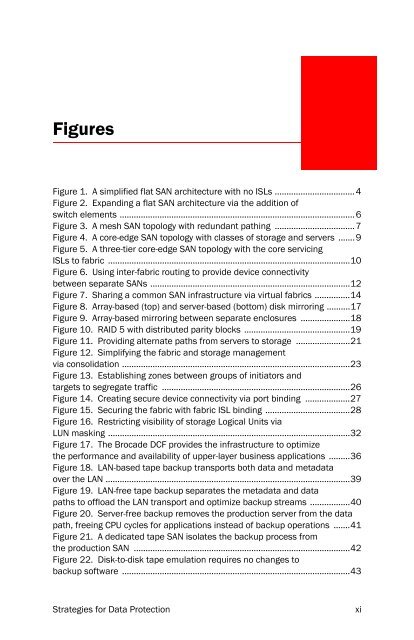Strategies for Data Protection - Brocade
Strategies for Data Protection - Brocade
Strategies for Data Protection - Brocade
- No tags were found...
Create successful ePaper yourself
Turn your PDF publications into a flip-book with our unique Google optimized e-Paper software.
FiguresFigure 1. A simplified flat SAN architecture with no ISLs ..................................4Figure 2. Expanding a flat SAN architecture via the addition ofswitch elements ....................................................................................................6Figure 3. A mesh SAN topology with redundant pathing ..................................7Figure 4. A core-edge SAN topology with classes of storage and servers .......9Figure 5. A three-tier core-edge SAN topology with the core servicingISLs to fabric .......................................................................................................10Figure 6. Using inter-fabric routing to provide device connectivitybetween separate SANs .....................................................................................12Figure 7. Sharing a common SAN infrastructure via virtual fabrics ...............14Figure 8. Array-based (top) and server-based (bottom) disk mirroring ..........17Figure 9. Array-based mirroring between separate enclosures .....................18Figure 10. RAID 5 with distributed parity blocks .............................................19Figure 11. Providing alternate paths from servers to storage .......................21Figure 12. Simplifying the fabric and storage managementvia consolidation .................................................................................................23Figure 13. Establishing zones between groups of initiators andtargets to segregate traffic ................................................................................26Figure 14. Creating secure device connectivity via port binding ...................27Figure 15. Securing the fabric with fabric ISL binding ....................................28Figure 16. Restricting visibility of storage Logical Units viaLUN masking .......................................................................................................32Figure 17. The <strong>Brocade</strong> DCF provides the infrastructure to optimizethe per<strong>for</strong>mance and availability of upper-layer business applications .........36Figure 18. LAN-based tape backup transports both data and metadataover the LAN ........................................................................................................39Figure 19. LAN-free tape backup separates the metadata and datapaths to offload the LAN transport and optimize backup streams .................40Figure 20. Server-free backup removes the production server from the datapath, freeing CPU cycles <strong>for</strong> applications instead of backup operations .......41Figure 21. A dedicated tape SAN isolates the backup process fromthe production SAN ............................................................................................42Figure 22. Disk-to-disk tape emulation requires no changes tobackup software .................................................................................................43<strong>Strategies</strong> <strong>for</strong> <strong>Data</strong> <strong>Protection</strong>xi
















